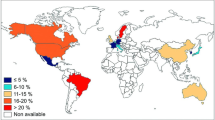Abstract
The N-hydroxyurea derivatives 70C ((E)-N-{3-[3-(4-fluorophenoxy)phenyl]-1-(R,S)-methylprop-2-enyl}-N-hydroxyurea) and its (R) 225C and (S) 404C enantiomers, which were being developed as 5-lipoxygenase inhibitors for the treatment of certain allergic and inflammatory conditions, were found to cause severe glomerulonephropathy in the rat. The lesion appeared to be of greater severity in female rats compared with male rats. In addition, 70C and 225C treated animals appeared more severely affected than 404C treated animals. Detailed examination of the lesion in animals dosed with 225C showed that there was a clear relationship between the onset of the lesion and the dose given, i.e. the higher the dose the sooner the lesion developed. The earliest changes detected in the kidney by transmission electron microscopy were noted in the glomeruli, in which the visceral cells appeared enlarged and showed varying degrees of foot process loss. In the more advanced lesion, the degree of foot process loss became more obvious and changes in the kidney tubules were seen by light microscopy. The morphological changes were mirrored by a dose-related increase in water consumption, an increased kidney to body weight ratio and gastrointestinal oedema, suggesting impaired renal function. Shortly after the onset of foot process loss, decreases in the total plasma protein and albumin and increases in the plasma cholesterol, triglycerides, urea and creatinine were recorded. These changes, particularly the foot-process loss, together with increased proteinuria, hypoalbuminaemia, hypercholesterolaemia and lipaemia, are all characteristic of “minimal change nephrotic syndrome”. Because of the serious nature of the kidney lesion caused by these N-hydroxyureas in the rat, it was considered that it precluded their development as therapeutic agents for use in man.
Similar content being viewed by others
References
Allchin JP, Evans GO (1986) A simple rapid method for the detection of rat urinary proteins by agarose electrophoresis and nigrosine staining. Lab Anim 20: 202–205
Arm JP, Lee TH (1993) Sulphidopeptide leukotrienes in asthma. Clin Sci 84: 501–510
Bertani J, Poggi A, Pozzoni R, Delaini F, Sacchi G, Thoua Y, Mecca G, Remuzzi G, Donati MB (1982) Adriamycin-induced nephrotic syndrome in rats: sequence of pathological events. Lab Invest 46: 16–23
Cameron JS, Turner DR, Ogg CS, Sharpstone P, Brown CB (1974) The nephrotic syndrome in adults with “minimal change” glomerular lesions. Q J Med 43: 461–488
Evans GO, Parsons CE (1986) Potential errors in the measurement of total protein in male rat urine using test strips. Lab Anim 20: 27–31
Humphrey CD, Pittmann FE (1974) A simple methylene blue-azure II-basic fuchsin stain for epoxy-embedded tissue sections. Stain Technol 49: 9–14
International Study of Kidney Disease in Children (1978) Nephrotic syndrome in children: prediction of histopathology from clinical and laboratory characteristics at time of diagnosis. Kidney Int 13: 159–165
Israel E, Rubin P, Kemp JP, Grossman J, Pierson W, Siegel SC, Tinkelman D, Murray JJ, Busse W, Segal AT, Fish J, Kaiser HB, Ledford D, Wenzel S, Rosenthal R, Cohn J, Lanni C, Pearlman H, Karahalios P, Drazen JM (1993) The effect of inhibition of 5-lipoxygenase by zileuton in mild-to-moderate asthma. Ann Int Med 199: 1059–1066
Lewis RA, Austen KF, Soberman RJ (1990) Leukotrienes and other products of the 5-lipoxygenase pathway — Biochemistry and relation to pathobiology in human diseases. N Engl J Med 323: 645–655
McDowell EM, Trump BF (1976) Histological fixatives suitable for diagnostic light and electron microscopy. Arch Pathol Lab Med 100: 405–414
Postek MT, Tucker SC (1977) Thiocarbohydrazide binding for botanical specimens for SEM. J Microsc 110: 71–74
Ryan GB, Karnovsky MJ (1975) An ultrastructural study of the mechanisms of proteinuria in aminonucleoside nephrosis. Kidney Int 8: 219–232
Shiraiwa K, Tsutsumi M, Konishi Y (1986) Daunomycin-induced nephropathy, rat. In: Jones TC, Mohr U, Hunt RD (eds) Urinary system, monographs on pathology of laboratory animals. Springer, Berlin Heidelberg New York London Paris Tokyo, pp 239–244
Stechschulte DJ (1990) Leukotrienes in asthma and allergic rhinitis. N Engl J Med 323: 1769–1770
Sternberg SS (1970) Cross-striated fibrils and other ultrastructural alterations in glomeruli of rats with daunomycin nephrosis. Lab Invest 23: 39–51
Sternberg SS, Philips FS (1967) Biphasic intoxication and nephrotic syndrome in rats given daunomycin (abstract). Proc Am Assoc Can Res 8: 64
Sternberg SS, Philips FS, Cronin AP (1972) Renal tumors and other lesions in rats following a single intravenous injection of daunomycin. Cancer Res 32: 1029–1036
Vernier RL, Papermaster BW, Good RA (1959) Aminonucleoside nephrosis. 1. Electron microscopic study of the renal lesion in rats. J Exp Med 109: 115–125
Wallace JL (1990) 5-Lipoxygenase: a rational target for therapy of inflammatory bowel disease. Trends Pharm Sci 11: 51–53
Author information
Authors and Affiliations
Rights and permissions
About this article
Cite this article
Read, N.G., Astbury, P.J., Evans, G.O. et al. Nephrotic syndrome associated with N-hydroxyureas, inhibitors of 5-lipoxygenase. Arch Toxicol 69, 480–490 (1995). https://doi.org/10.1007/s002040050202
Received:
Accepted:
Issue Date:
DOI: https://doi.org/10.1007/s002040050202




